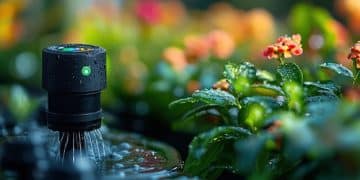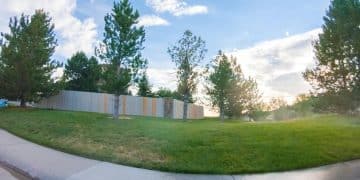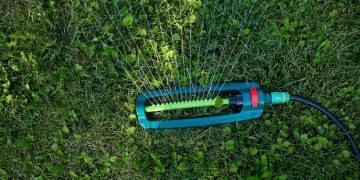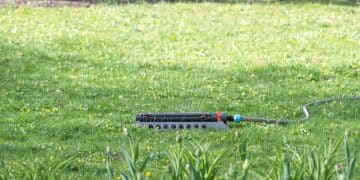Smart Garden Systems: Grow Herbs & Veggies Indoors Automatically
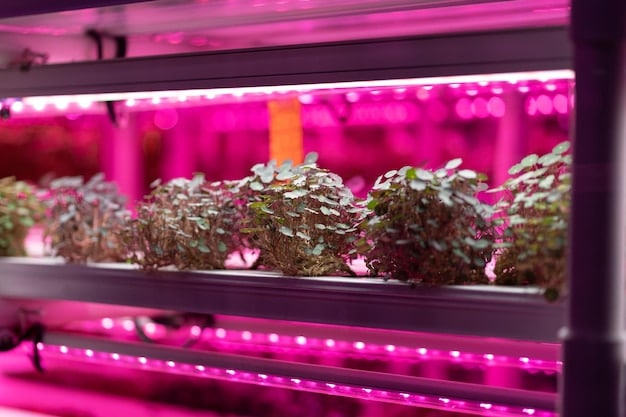
Smart garden systems automate indoor herb and vegetable cultivation by regulating lighting and watering, providing a controlled environment for year-round gardening.
Imagine fresh herbs and vegetables flourishing in your home, regardless of the season. Smart garden systems: growing herbs and vegetables indoors with automated lighting and watering make this a reality, bringing the joys of gardening inside with minimal effort.
Understanding Smart Garden Systems
Smart garden systems represent a technological leap in indoor gardening, offering a streamlined and efficient way to cultivate plants within the comfort of your home. These systems are designed to mimic the optimal conditions found in nature, but with the added convenience of automation and precise control.
Key components of these systems include automated watering mechanisms, sophisticated lighting solutions, and often, integrated sensors that monitor environmental conditions. This technology allows for optimized plant growth, regardless of the external climate or available natural light.
Components of a Smart Garden System
A typical smart garden system comprises several essential components working in harmony to foster plant growth. Each component plays a crucial role in creating the ideal environment for herbs and vegetables to thrive indoors.
- LED Grow Lights: Providing the necessary light spectrum for photosynthesis, these lights are often programmable to simulate daylight cycles.
- Automated Watering System: This ensures consistent moisture levels, preventing both overwatering and underwatering, critical for healthy plant development.
- Nutrient Delivery: Many systems include a method for delivering essential nutrients directly to the roots, optimizing growth and yield.
- Sensors and Controls: These monitor factors like humidity, temperature, and pH levels, allowing for adjustments to maintain optimal conditions.
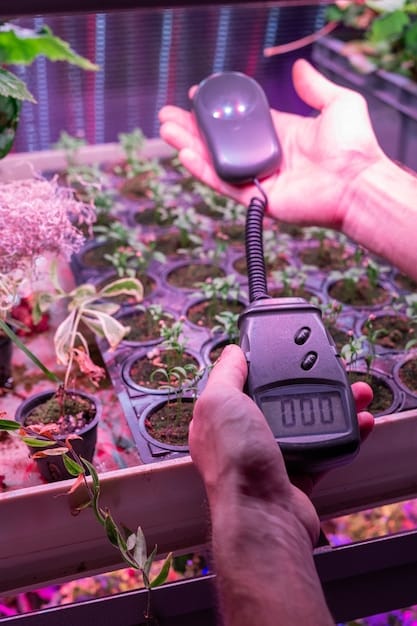
By integrating these elements, smart garden systems provide a comprehensive solution for indoor gardening, making it simpler for users to enjoy fresh produce year-round.
Benefits of Indoor Gardening with Automation
Embracing smart garden systems for indoor gardening unlocks a wealth of benefits, making it an appealing choice for both seasoned gardeners and beginners alike. These advantages range from environmental control to enhanced convenience and yield.
Automated lighting and watering not only simplify the gardening process but also contribute to more consistent and predictable results. This can be particularly advantageous in urban settings or locations with challenging outdoor climates.
Year-Round Harvests
One of the most significant advantages is the ability to enjoy fresh herbs and vegetables throughout the year, regardless of seasonal limitations. Smart garden systems create a stable, controlled environment that is not subject to external weather conditions.
Increased Control Over Growing Conditions
These systems empower users with unprecedented control over factors such as light exposure, humidity, and nutrient levels. This level of precision is difficult to achieve with traditional outdoor gardening, allowing for optimized plant growth.
- Pest and Disease Control: Indoor gardens are less susceptible to common pests and diseases, reducing the need for chemical treatments.
- Space Efficiency: Smart garden systems are designed to maximize space, making them ideal for apartments, condos, and other urban dwellings.
- Sustainable Gardening: By reducing water waste and eliminating the need for pesticides, these systems promote a more sustainable approach to food production.
Ultimately, these benefits make smart garden systems a valuable investment for those seeking a convenient, efficient, and environmentally friendly way to grow their own food.
Choosing the Right Smart Garden System
Selecting the ideal smart garden system requires careful consideration of various factors, including your gardening goals, available space, and budget. There are numerous systems on the market, each with its own set of features and capabilities.
It’s essential to assess what you hope to achieve with your indoor garden and identify the specific features that align with your needs. Whether you prioritize a compact design, advanced automation, or specific plant compatibility, there is likely a system that fits the bill.
Factors to Consider
When evaluating different smart garden systems, several critical factors should influence your decision. These considerations will help ensure that you choose a system that meets your requirements and provides a satisfying gardening experience.
Consider the size of your space, the types of plants you want to grow, and your budget. These will help narrow down your options.
- Size and Capacity: Determine the amount of space you have available and the number of plants you wish to cultivate.
- Lighting Technology: LED grow lights are generally preferred for their energy efficiency and customizable spectrum.
- Watering System: Look for systems with reliable and automated watering mechanisms to prevent over or underwatering.
- Smart Features: Consider systems with integrated sensors and controls that allow for remote monitoring and adjustments.
Consider also the types of herbs and vegetables you’re planning to grow. Some systems are better suited for certain plants than others. Look for a system that meets your needs and offers the controls you want.
Setting Up Your Smart Garden
The setup process for a smart garden system is generally straightforward, but it’s essential to follow the manufacturer’s instructions carefully to ensure optimal performance. This includes proper assembly, placement, and initial programming.
Before starting, gather all the necessary components and tools, and designate a suitable location for your garden. The chosen spot should be easily accessible and provide ample space for the system to operate.
Step-by-Step Guide
While specific instructions may vary depending on the system, the following steps provide a general overview of the setup process. Adhering to these guidelines will help you get your smart garden up and running smoothly.
Read the manufacturer’s instructions carefully. Clear instructions are vital for proper setup. It’s a good idea to watch videos and read online forums to learn from other users too.
- Assemble the System: Follow the manufacturer’s instructions to assemble the frame, reservoir, and other structural components.
- Install Lighting: Attach the LED grow lights and ensure they are properly positioned to provide adequate coverage for your plants.
- Configure Watering System: Connect the watering pump, tubing, and nozzles, and program the watering schedule according to your plants’ needs.
- Add Nutrients: Introduce the recommended nutrient solution to the water reservoir, following the manufacturer’s guidelines.
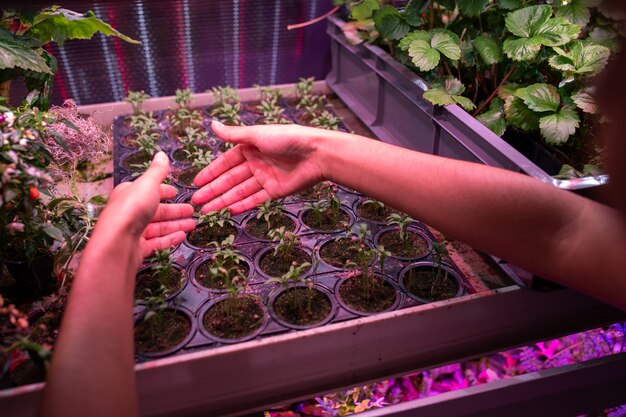
Setting up a smart garden can be a fun project. Enlist a friend or family member to assist and make it a shared experience. Don’t hesistate to reach out to the manufacturer for support If you encounter any issues.
Maintaining Your Indoor Smart Garden
Proper maintenance is crucial for the long-term success of your indoor smart garden. Regular upkeep ensures that your plants receive the optimal environment and nutrients they need to thrive.
Maintenance tasks include monitoring water and nutrient levels, pruning and trimming plants, and cleaning the system to prevent algae growth. By establishing a consistent maintenance routine, you can minimize potential problems and maximize your harvests.
Essential Maintenance Practices
Implementing the following maintenance practices will help ensure the health and productivity of your smart garden. These tasks are relatively simple but can make a significant difference in the overall outcome.
One of the benefits of smart gardens is that the maintenance is scheduled. Still, always be ready for troubleshooting. Smart gardens can still be sensitive to fluctuations, so observe the status of your plants frequently, and check that hoses and nozzles are not clogged when watering.
- Monitor Water and Nutrient Levels: Regularly check the water reservoir and replenish nutrients as needed, following the manufacturer’s recommendations.
- Prune and Trim Plants: Remove dead or yellowing leaves and trim overgrown stems to promote healthy growth and airflow.
- Clean the System: Periodically clean the reservoir, tubing, and nozzles to prevent algae growth and maintain optimal water flow.
- Adjust Lighting: Adjust the height and intensity of the LED grow lights as your plants grow to ensure they receive adequate light exposure.
Troubleshooting Common Issues
Even with the best planning and maintenance, you may encounter occasional issues with your smart garden system. Being able to identify and address these problems promptly can prevent them from escalating.
Common issues include nutrient deficiencies, pest infestations, and lighting problems. By understanding the symptoms and potential solutions for these issues, you can keep your garden thriving.
Identifying and Resolving Problems
Here are some common problems and potential steps you can take to resolve them. If the issue persists or you are unsure how to proceed, consult the manufacturer’s support resources or an experienced gardener.
Smart gardens can be affected by temperature, environmental pH and even static electricity. If you’re keeping your smart garden by a window, be aware of temperature changes. Take time to learn the common diseases in the plants you select.
- Nutrient Deficiencies: Symptoms include yellowing leaves, stunted growth, and poor flowering. Adjust nutrient levels according to your plants’ needs.
- Pest Infestations: Look for signs of pests, such as aphids, spider mites, or whiteflies. Use organic pest control methods or insecticidal soap to eliminate them.
- Lighting Problems: Ensure that the LED grow lights are functioning correctly and providing adequate light intensity for your plants.
- Watering Issues: Symptoms can include wilting plants or root rot. Adjust the watering schedule to ensure proper moisture levels.
| Key Point | Brief Description |
|---|---|
| 🌱 Automated Watering | Ensures consistent moisture levels for optimal plant growth automatically. |
| 💡 LED Grow Lights | Provides the light spectrum needed for year-round photosynthesis indoors. |
| 🌡️ Controlled Environment | Offers stable conditions, protecting plants from pests and weather. |
| 🌿 Year-Round Harvest | Enables continuous harvesting of fresh herbs and vegetables, regardless of the season. |
Smart garden systems offer year-round harvests, increased control over growing conditions, and space efficiency, making them ideal for urban living. They also promote sustainable gardening practices. Automated lighting systems use LED grow lights to simulate daylight, while watering systems deliver precise amounts of water to plants, preventing over or underwatering, ensuring consistent moisture. You can grow a variety of herbs, leafy greens, and small vegetables in a smart garden system. Options include basil, mint, lettuce, spinach, and even strawberries or peppers. Maintenance involves regularly monitoring water and nutrient levels, pruning plants, and cleaning the system to prevent algae growth. A consistent routine ensures your garden thrives, so always check regularly! Check for nutrient deficiencies, pests, or inadequate lighting. Adjust the system settings and consult the manufacturer’s resources or a local gardening expert to troubleshoot. Smart garden systems: growing herbs and vegetables indoors with automated lighting and watering offer a convenient and efficient way to enjoy fresh produce year-round. By understanding the benefits, selecting the right system, and implementing proper maintenance practices, you can create a thriving indoor garden that enhances your home and lifestyle.
▼
▼
▼
▼
▼Conclusion
